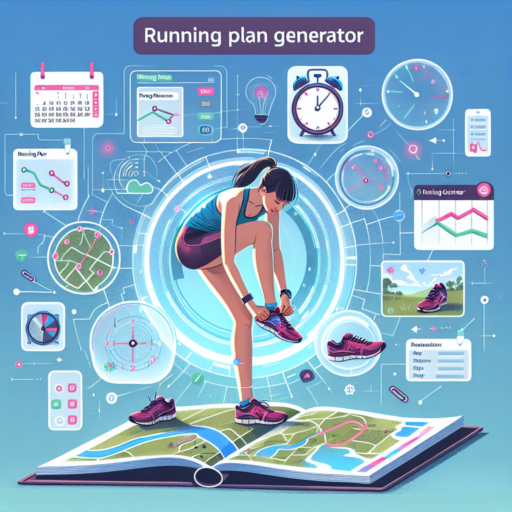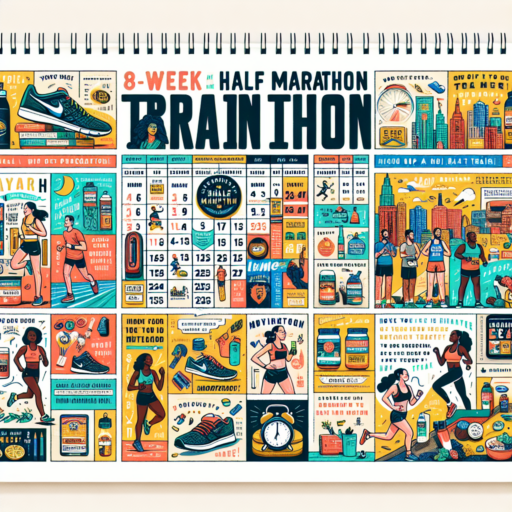What Is a Running Plan Generator?
A Running Plan Generator is a digital tool designed to create customized running or training plans catered to an individual’s fitness level, goals, and schedule. By inputting specific data such as your current running ability, desired distance, and available training days, these generators use algorithms to craft a personalized plan that gradually increases in intensity. The aim is not only to help runners achieve their goals but also to minimize the risk of injury by ensuring a balanced approach to training intensity and recovery time.
Unlike generic training plans found in books or online, a Running Plan Generator offers a more personalized experience. It considers the nuances of an individual’s life and physical condition, adjusting for factors such as rest days and preference for cross-training. This tailored approach helps in maintaining motivation, as the plan evolves with your progress, ensuring challenges remain appropriate and goals achievable. Additionally, some advanced generators also incorporate feedback loops, allowing plans to be refined based on your progress and any physical feedback you input.
At its core, the technology behind a Running Plan Generator is based on training principles and data analysis. By leveraging vast amounts of data from a wide range of runners and performance outcomes, these tools can offer evidence-based recommendations for optimal training loads and progression. This intelligent use of data makes running plan generators an invaluable tool for runners of all levels looking to optimize their training and maximize their performance safely.
Benefits of Using a Running Plan Generator for Your Training
Utilizing a running plan generator for your training regimen brings manifold advantages that are essential for runners aiming to reach their peak performance. These digital planners are designed to tailor your running schedule based on personal goals, current fitness levels, and availability, which means each training plan is as unique as the runner themselves. This personalized approach ensures that you’re not just following a generic program but one that’s specifically crafted for you.
Customized Training Plans to Meet Individual Goals
One significant benefit of using a running plan generator is the ability to receive a customized training plan that aligns with your individual goals, whether it’s improving your marathon time, increasing your distance, or simply staying active. The specificity of the plan helps in targeting the right areas and provides a structured roadmap, which can significantly enhance your running efficiency and effectiveness over time.
Adaptability to Your Schedule and Progress
Another advantage of these planning tools is their adaptability. Life can be unpredictable, and your training schedule needs to be flexible enough to accommodate unexpected changes. Running plan generators allow for adjustments based on your real-time progress and any alterations in your availability, ensuring that your training remains on track without overwhelming you or sacrificing other life commitments.
In summary, leveraging a running plan generator for your training can lead to more personalized, adaptable, and effective running routines. The focus on individual goals and the flexibility offered by these tools not only keep you motivated but also contribute to achieving your running aspirations in a structured and efficient manner.
How to Choose the Best Running Plan Generator: Key Features to Look For
Finding the perfect running plan generator can significantly impact your training progress, efficiency, and overall motivation. To ensure you select the application or website that best meets your needs, it’s essential to focus on a few key features that distinguish the superior choices from the plethora. Identifying these features will help you tailor your running journey towards your specific goals, whether you’re a beginner aiming for your first 5k or an experienced marathoner looking to beat your personal best.
Personalization Options
The ability to customize your running plan is crucial. A top-notch running plan generator should offer personalization options based on your current fitness level, goals, and availability. This means the program can adapt to your personal progress, ensuring you’re always challenged appropriately without risking overtraining or undertraining. Look for a tool that asks detailed questions about your running history, target race distances, and time goals to craft a truly personalized plan.
Integration with Wearable Technology
In today’s tech-savvy world, the best running plan generators often integrate seamlessly with various wearable technologies, such as smartwatches and fitness trackers. This integration allows for real-time tracking of your runs, monitoring your heart rate, pace, and distance. By choosing a generator with this capability, you can ensure your running plan is not only tailored to your goals but also dynamically adjusts based on the physical feedback from your training sessions.
Step-by-Step Guide: How to Use a Running Plan Generator Effectively
Using a running plan generator can be a pivotal step in achieving your running goals, whether you’re gearing up for your first 5K or aiming to conquer a marathon. These innovative tools are designed to personalize your training schedule based on your current fitness level, goals, and available training time. However, navigating these platforms effectively requires understanding a few key steps to ensure your success.
Select the Right Running Plan Generator
First and foremost, you must choose a running plan generator that aligns with your specific needs. Look for features such as customizable training plans, feedback systems, and integration with fitness tracking devices. It’s also important to select a generator that has options for your specific race distance or running goals. Paying attention to reviews and recommendations from fellow runners can provide valuable insights into the most reliable and user-friendly platforms.
Input Accurate Information
Once you’ve selected a generator, the next step is to input your details accurately. Most generators will ask for information regarding your current fitness level, the distance you’re training for, and your goal time if you have one. Some might also inquire about how many days a week you can dedicate to training and your preference for workout types (e.g., speedwork, long runs, cross-training). Ensuring the information you provide is as accurate and honest as possible will help the generator create the most effective and tailored training plan for you.
Follow the Plan but Be Flexible
Having received your personalized training plan, it’s crucial to commit to it. However, it’s equally important to listen to your body and be flexible. If you’re feeling overly fatigued, or if you’re nursing a minor injury, it may be wise to adjust your training days or modify the intensity of your workouts. Remember, the plan is a guide meant to enhance your running performance and enjoyment, not a rigid schedule that must be followed at the expense of your health or well-being.
No se han encontrado productos.
Top 5 Running Plan Generators Reviewed: Pros and Cons
Finding the perfect running plan can be a daunting task. Whether you’re a seasoned runner or just lacing up your sneakers for the first time, a structured plan is vital for success. To simplify your search, we’ve delved into the top 5 running plan generators, analyzing their pros and cons. These tools vary in their approach—from algorithm-based personalization to community-driven content—yet each offers unique benefits to cater to individual needs and goals. Here’s what you need to know.
1. RunnersConnect:
This generator stands out for its blend of technology and human expertise. Pros: Tailored plans that adapt to your progress, with the added benefit of access to professional coaches. Cons: The subscription fee might be a hurdle for those seeking free options.
2. MyRunPlan:
Pros: Offers high flexibility and adjustments based on user feedback, making it great for runners whose schedules are in constant flux. Cons: Its algorithm’s reliance on user input for adjustments may lead to less accurate tailoring for those who aren’t meticulous record-keepers.
3. Garmin Coach:
For tech-savvy runners with a Garmin device, this generator integrates seamlessly. Pros: Direct synchronization with Garmin devices for real-time tracking and adjustments. Cons: Limited to Garmin users, which restricts access for runners using other brands.
Each running plan generator offers unique features designed to meet different needs and preferences. From personalized coaching access to tech integration, the choices cater to a wide range of runners. Yet, the cons highlighted—such as subscription costs and brand exclusivity—underscore the importance of selecting a tool that aligns with your specific circumstances and goals.
Customizing Your Running Plan: Tips for Beginners and Advanced Runners
Creating a customized running plan that suits your fitness level and goals is crucial whether you’re just starting or have been hitting the pavement for years. For beginners, the focus should be on building endurance and incorporating running into your lifestyle in a sustainable way. Meanwhile, advanced runners might look towards refining their strategy, improving speed, and increasing distance without risking injury.
Beginner Running Tips
- Start with short distances and gradually increase your mileage.
- Incorporate rest days to allow your body to recover.
- Focus on consistency rather than speed in the initial stages.
Advanced Running Tips
- Introduce interval training and tempo runs to improve your speed and stamina.
- Incorporate strength training to support your running and prevent injuries.
- Set specific, measurable goals to track your progress and stay motivated.
Remember, every runner’s journey is unique. Customizing your running plan involves listening to your body, being patient with your progress, and adjusting your strategy as you evolve. Whether you’re lacing up for the first time or prepping for your next marathon, the key is to find joy in the process and celebrate your achievements along the way.
Integrating Your Running Plan with Other Fitness Apps
In today’s digitally driven world, integrating your running plan with other fitness apps can revolutionize your training experience. By synchronizing your running routine across various platforms, you gain comprehensive insights into your activities, promoting a holistic approach to fitness. This integration is not just about tracking miles; it’s about understanding the interplay between different types of exercise and how they can complement your running goals.
One of the key benefits of integrating your running plan with other fitness apps is the ability to cross-reference data. For instance, strength training, when logged in a separate app, can be analyzed alongside your running progress to ensure that you’re building muscle in a way that enhances, rather than hinders, your running performance. More so, dietary tracking apps can provide vital information on your nutrition intake, ensuring your fueling strategy aligns with your running needs.
Furthermore, many fitness apps now offer community features, allowing runners to connect with others, share successes, and even compete in virtual challenges. This social aspect can be incredibly motivating, encouraging you to stick to your running plan while also exploring new workout routines recommended by peers. Through these integrations, your running plan becomes not just about hitting the pavement, but about being a part of a broader fitness journey.
Frequently Asked Questions About Running Plan Generators
When it comes to crafting your ideal running plan, many turn to running plan generators for a personalized schedule. However, there are always questions about how these generators work, their accuracy, and how to get the best out of them.
How Accurate Are Running Plan Generators?
Running plan generators are designed with algorithms based on general fitness principles and user-provided data such as current fitness level, goals, and availability. While they offer a good starting point, it’s important to remember that personal adjustments may be necessary. Individual factors like recovery rates, altitude, and temperature can’t always be fully accounted for by a generator.
Can Beginners Use Running Plan Generators?
Absolutely! Most running plan generators have settings specifically for beginners. These plans usually start with a mix of walking and running to gradually increase endurance and reduce the risk of injury. Remember to choose a beginner-friendly option when setting up your plan, and don’t hesitate to modify it if you find it too challenging or too easy as you progress.
How Often Should I Update My Running Plan?
Adjusting your running plan is essential for continuous improvement and avoiding plateaus. Ideally, you should evaluate and adjust your plan every four to six weeks. This timeframe allows you to gauge your progress and make necessary changes, whether it’s increasing your distance, adding speed work, or incorporating more rest days based on how your body is responding.
Success Stories: How a Running Plan Generator Helped Me Reach My Goals
Finding the right path to achieving running goals can be daunting for many, from beginner runners to those who are more experienced. I discovered how a Running Plan Generator was a game-changer for me, providing a personalized and adaptable roadmap to success. In this journey, the importance of structure, motivation, and adaptability became clear, all thanks to this innovative tool.
Personalized Running Plans
One of the most significant advantages of the Running Plan Generator is its ability to tailor plans specifically to individual needs and goals. Whether it was aiming for a 5K or preparing for a marathon, the generator adapted seamlessly. This personalization took into account my available days to train, pace, and even how I felt on certain days, making my goals more attainable and less intimidating.
Keeping Motivation High
Motivation is crucial when pushing towards a running goal. The Running Plan Generator kept me engaged by tracking progress and adjusting the plan as I improved. Celebrating those small victories became a daily ritual, and observing my gradual progression provided a considerable boost. This aspect was essential in maintaining my drive and focus, especially on days when lacing up seemed like a monumental task.
The story of how a Running Plan Generator helped me reach my running goals is not just about the technology but also about finding a support system within it. The journey taught me the importance of flexibility in training and how adapting plans to one’s evolving capabilities is crucial. Above all, it made achieving my running goals not only possible but enjoyable.
Avoiding Common Mistakes When Following a Generated Running Plan
When embarking on a journey with a generated running plan, the path to achieving your fitness goals is often filled with excitement and motivation. However, without proper guidance, it’s easy to fall into common traps that can hinder your progress. Understanding these pitfalls is the first step towards optimizing your running regimen and securing the best results.
Misinterpreting Pace and Intensity
One of the critical mistakes many runners make is misinterpreting the pace and intensity required for their runs. A generated plan provides a structured outline, but recognizing your body’s limits is essential. Pushing too hard without adequate rest or not challenging yourself enough can both be detrimental. It’s critical to balance effort with recovery, ensuring that each run builds your strength and endurance without leading to burnout or injury.
Skipping Rest Days
Another common pitfall is skipping rest days. Many athletes, driven by enthusiasm, often overlook the importance of recovery. Rest days are crucial components of a running plan; they allow your body to heal, adapt, and strengthen. Ignoring these days can lead to increased risk of injury and may actually set you back in your training. Remember, progress occurs not just during the run but in the recovery period that follows.
Ignoring Personalization Needs
Lastly, failing to personalize a generated running plan to fit your unique needs can be a significant oversight. No plan is one-size-fits-all, and adjusting the schedule to accommodate your lifestyle, fitness level, and goals is essential for sustained progress. Whether it’s modifying distances, incorporating cross-training, or adjusting pace, tailoring the plan ensures it remains effective and enjoyable throughout your training journey.




